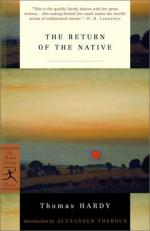|
|
Return of the Native Author/Context
Thomas Hardy was born in Upper Bockhampton, Dorset, England on June 2, 1840. An extremely gifted child, Hardy attended Mr. Last's Academy for Young Gentlemen in Dorchester, where he studied Latin, English and French, and even attempted to learn German by himself. In 1855, at age fifteen, Hardy began teaching at Stinsford Church Sunday School.
Hardy entered John Hicks's architectural firm at age sixteen. He did not especially enjoy being an architectural apprentice, but felt it was a sensible thing to do. His specialty was Gothic churches. He traveled to London in 1862 and ended up staying there for five years, working for Arthur Blomfield, an architect and church-restorer. Although Hardy was successful in London, earning several prizes, including an essay prize and a medal awarded by the Royal Institute of British Architects and the honor of the publication of his "How I Built Myself a House" in Chambers' Journal, creative writing was the more important activity on his mind. The great success of Charles Swineburne's poems fascinated Hardy and attracted him to the idea of writing for a living. He studied poets such as Shelley, Browning and Wordsworth diligently and imitated their style and diction. Hardy submitted a manuscript of his poetry to Chambers' Journal, the same company that published his "How I Built Myself A House", but the manuscript was rejected.
His intensive devotion to poetry resulted in a loss of enthusiasm for architectural work. Hardy left Blomfield's firm and returned to John Hicks's firm in Dorset in 1867, again working on church restoration. Here he truly began to devote much of his time to writing fiction, progressing with his first novel, The Poor Man and the Lady, which he submitted to Macmillan but was never published. He also tried sending his second novel manuscript, Desperate Remedies, to Macmillan, but the company rejected his work yet again. Hardy was so desperate that his work be published that he paid for the costs himself: Tinsley Brothers published Desperate Remedies in 1871. Hardy's next two works, Under the Greenwood Tree (1872) and A Pair of Blue Eyes (1873), introduced one of his central themes: the comic and tragic conflict between the simple life of the countryside and the glamorous sophistication of the city.
While traveling in Cornwall for business under Blomfield's firm, Hardy met Emma Lavinia Gifford and they fell in love. After four years of friendship and courtship, Hardy married Emma on September 17, 1874. Hardy had to ensure that he had enough of a salary from his writing to marry Emma. The Hardys lived in several locations over the next few years, traveling to Germany and Holland and various homes in Dorset, before settling in Max Gate, the home Hardy designed and had built in Dorchester.
The Hardys' marriage was never easy, as Emma thought her status superior to her husband's. Hardy had always felt more at ease at home in the countryside, and Emma's aristocratic city ways were unbearable for Hardy at times. Emma was said to be so snobbish that she refused to let Hardy's parents visit them at the beautiful Max Gate.
Hardy published a number of novels and poems in his extensive literary career: Far From the Madding Crowd (1874), The Return of the Native (1878), The Trumpet-Major (1880), A Laodicean (1881), The Mayor of Casterbridge (1886), The Woodlanders (1887), Wessex Tales (1888), Tess of the d'Urbervilles (1891), Jude the Obscure (1895), and The Well-Beloved (1898). He drew upon his memories and experiences as a youth growing up in rural Dorset for many of his novels, incorporating many customs and myths native to the land and culture.
The terrible public reception of Tess of the d'Urbervilles and later of Jude the Obscure (critics and the audience considered both too scandalous) caused Hardy to abandon fiction for poetry and history. Hardy had always felt that poetry was his one true calling and he returned to composing poems. His Wessex Poems and Poems of the Past and the Present were published in 1898 and 1901, respectively. He later became famous for his epic drama of the Napoleonic War, The Dynasts (Part 1 was published in 1904 and Part 2 in 1906).
Emma's death in 1912 left Hardy feeling extremely sad and lonesome. Even though they had their share of problems, he had lost his companion of many years and his great love. Adding to his grief and pain was the number of frequent callers who wished to visit the famed author. Hardy, very much valuing his privacy and solitude, needed someone whose stability and reassurance could lift his spirits - and he found that someone in Florence Dugdale, his secretary and longtime friend. Florence later became Hardy's second wife, marrying him in 1914, and eventually finishing his autobiography, The Life of Thomas Hardy, after his death on January 11, 1928.
Thomas Hardy is buried in Westminster Abbey. His legacy to the literary canon is his portrayal of the people, language and customs of the English countryside in his novels. From Far From the Madding Crowd to Jude the Obscure, Hardy gave voice to the people of his fictional Wessex.
Bibliography
Hands, Timothy. Thomas Hardy. New York: St. Martin's Press, 1995.
Hardy, Thomas. The Return of the Native. New York: Pocket Books, 1952.
Page, Norman, ed. Thomas Hardy: The Writer and his Background. New York: St. Martin's Press, 1980.
Weber, Carl. Hardy of Wessex: His Life and Literary Career. New York: Columbia University Press, 1965.




